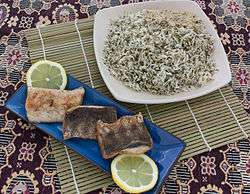Nowruz
| Nowruz نوروز | |
|---|---|
 A Haft-Seen table. | |
| Also called |
Albanian: Novruzit Azerbaijani: Novruz Dari: نوروز Nauruz Georgian: ნავრუზი Navruzi Gujarati: નવરોઝ Navarōjha Kazakh: Наурыз Nawryz Kurdish: نەورۆز Newroz Kyrgyz: Нооруз Nooruz Ossetian: Новруз Novruz Pashto: نوروز Nawróz Tajik: Наврӯз Navrūz Tati: Nuruz Turkish: Nevruz Turkmen: Nevruz Uzbek: Navruz |
| Observed by |
|
| Type | National, ethnic, international |
| Significance | New Year holiday |
| Celebrations | Haft-Seen, Charshanbe Suri, Sizdebedar, etc. |
| Date | March 20, 21, or 22 |
| 2016 date |
Sunday 20 March 2016 at 04:30 UTC * |
| 2017 date |
Monday 20 March 2017 at 10:29 UTC * |
| 2018 date |
Tuesday 20 March 2018 at 16:15 UTC * |
| 2019 date |
Wednesday 20 March 2019 at 21:58 UTC * |
| Frequency | annual |
| Norooz, Nawrouz, Newroz, Novruz, Nowrouz, Nowrouz, Nawrouz, Nauryz, Nooruz, Nowruz, Navruz, Nevruz, Nowruz, Navruz | |
|---|---|
| Country | Iran, Afghanistan, Azerbaijan, India, Iraq, Kazakhstan, Kyrgyzstan, Pakistan, Tajikistan, Turkey, Turkmenistan and Uzbekistan |
| Reference | 1161 |
| Region | Asia and the Pacific |
| Inscription history | |
| Inscription | 2016 (4th session) |
Nowruz (Persian: نوروز Nowruz; [nouˈɾuːz]; literally "new day") is the name of the Iranian New Year,[30][31] also known as the Persian New Year,[32][33] which is celebrated worldwide by the Iranians, along with some other ethno-linguistic groups, as the beginning of the New Year.
It has been celebrated for over 3,000 years in Western Asia, Central Asia, the Caucasus, the Black Sea Basin and the Balkans.[34][35][36][37][38][39][40][41][42] It marks the first day of the first month (Farvardin) in the Iranian calendar.[43]
Nowruz is the day of the vernal equinox, and marks the beginning of spring in the Northern Hemisphere. It usually occurs on March 21 or the previous or following day, depending on where it is observed. The moment the sun crosses the celestial equator and equalizes night and day is calculated exactly every year, and families gather together to observe the rituals.
Although having Iranian and religious Zoroastrian origins, Nowruz has been celebrated by people from diverse ethno-linguistic communities for thousands of years. It is a secular holiday for most celebrants that is enjoyed by people of several different faiths, but remains a holy day for Zoroastrians.[44]
Etymology
The term Nowruz is a Persian compound word, consisting of the words now and ruz. Now (Old Persian: nava), which means "new" and descends from Proto-Indo-European *néwos, is cognate with English new , German neu, Latin novus, Greek νέος (neos), Russian новый (novyj), and Sanskrit नव (náva). Ruz (Middle Persian: rōz, rōj; Avestan: raocah), which means "day" in Modern Persian, is descended from Proto-Iranian *raučah-, itself derived from Proto-Indo-European *lewk-. The original meaning of the word, however, was "light". It is related to Armenian loys, English light, Latin lux, Sanskrit rúci and Slovenian luč.[45][46]
Regional variations in pronunciation
The Persian pronunciation differs in the many dialects of the language. While the eastern dialects have preserved the diphthong nau (IPA: [næuˈɾoːz]), the western dialects usually pronounce it with the diphthong now (IPA: [nouˈɾuːz]), and some colloquial variants (such as the Tehrani accent) pronounce it with a long monophthong (IPA: [noːˈɾuːz]).
Spelling variations
A variety of spelling variations for the word Nowruz exist in English-language usage. Random House (unabridged) provides the spelling Nowruz.[47]
Merriam-Webster (2006) recognizes only the spelling "Nauruz" (and a contestant in the final session of the 2006 Scripps National Spelling Bee in the United States, Allion Salvador, was disqualified on that basis).[48][49][50][51]
History and origin
Ancient roots
Although it is not clear whether Proto-Indo-Iranians celebrated a feast as the first day of the calendar, there are indications that Iranians may have observed the beginning of both autumn and spring, respectively related to the harvest and the sowing of seeds, for the celebration of the New Year.[52] Mary Boyce and Frantz Grenet explain the traditions for seasonal festivals and comment: "It is possible that the splendor of the Babylonian festivities at this season led the Iranians to develop their own spring festival into an established New Year feast, with the name Navasarda "New Year" (a name which, though first attested through Middle Persian derivatives, is attributed to the Achaemenian period)." Since the communal observations of the ancient Iranians appear in general to have been a seasonal ones, and related to agriculture, "it is probable that they traditionally held festivals in both autumn and spring, to mark the major turning points of the natural year."[52]
Nowruz is partly rooted in the tradition of Iranian religions, such as Mitraism and Zoroastrianism. In Mitraism, festivals had a deep linkage with the sun's light. The Iranian festivals such as Mehrgan (autumnal equinox), Tirgan, and the eve of Chelle ye Zemestan (winter solstice) also had an origin in the Sun god (Surya). Among other ideas, Zoroastrianism is the first monotheistic religion that emphasizes broad concepts such as the corresponding work of good and evil in the world, and the connection of humans to nature. Zoroastrian practices were dominant for much of the history of ancient Iran. In Zoroastrianism, the seven most important Zoroastrian festivals are the six Gahambar festivals and Nowruz, which occurs at the spring equinox. According to Mary Boyce,[53] "It seems a reasonable surmise that Nowruz, the holiest of them all, with deep doctrinal significance, was founded by Zoroaster himself"; although there is no clear date of origin.[54] Between sunset on the day of the sixth Gahambar and sunrise of Nowruz, Hamaspathmaedaya (later known, in its extended form, as Frawardinegan; and today known as Farvardigan) was celebrated. This and the Gahambars are the only festivals named in the surviving text of the Avesta.
The 10th-century scholar Biruni, in his work Kitab al-Tafhim li Awa'il Sina'at al-Tanjim, provides a description of the calendars of various nations. Besides the Iranian calendar, various festivals of Greeks, Jews, Arabs, Sabians, and other nations are mentioned in the book. In the section on the Iranian calendar, he mentions Nowruz, Sadeh, Tirgan, Mehrgan, the six Gahambars, Farvardigan, Bahmanja, Esfand Armaz and several other festivals. According to him, "It is the belief of the Iranians that Nowruz marks the first day when the universe started its motion."[55] The Persian historian Gardizi, in his work titled Zayn al-Akhbār, under the section of the Zoroastrians festivals, mentions Nowruz (among other festivals) and specifically points out that Zoroaster highly emphasized the celebration of Nowruz and Mehrgan.[56][57]
Achaemenid period
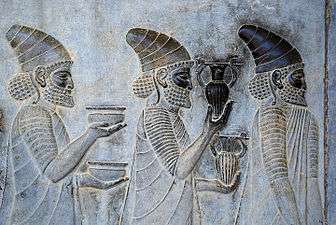
It has been suggested that the famous Persepolis complex, or at least the palace of Apadana and the Hundred Columns Hall, were built for the specific purpose of celebrating a feast related to Nowruz. Although there may be no mention of the term Nowruz in recorded Achaemenid inscriptions,[58] there is a detailed account by Xenophon of a Nowruz celebration taking place in Persepolis and the continuity of this festival in the Achaemenid tradition.[59] It was an important day during the time of the Achaemenids (c. 550–330 BCE), where kings from different nations under the Achaemenid Empire used to bring gifts to the King of Kings of Iran. The significance of the ceremony in the Achaemenid Empire was such that King Cambyses II's appointment as the king of Babylon was legitimized only after his participation in the referred annual Achaemenid festival.[60] It was, therefore, a highly auspicious occasion for the ancient Iranian peoples.
In 539 BC, the Jews came under Iranian rule, thus exposing both groups to each other's customs. According to the Encyclopædia Britannica, the story of Purim as told in the Book of Esther is adapted from an Iranian novella about the shrewdness of harem queens, suggesting that Purim may be a transformation of the Iranian New Year.[61] A specific novella is not identified and Encyclopædia Britannica itself notes that "no Jewish texts of this genre from the Persian period are extant, so these new elements can be recognized only inferentially". The Encyclopaedia of Religion and Ethics notes that the Purim holiday is based on a lunar calendar, while Nowruz occurs at the spring equinox (solar calendar). The two holidays are therefore celebrated on different dates but within a few weeks of each other, depending on the year. Given their temporal associations, it is possible that the Jews and Iranians of the time may have shared or adopted similar customs for these holidays.[62] The story of Purim as told in the Book of Esther has been dated around 625–465 BC (although the story takes place with the Jews under the rule of the Achaemenid Empire and the Jews had come under Iranian rule in 539 BC), while Nowruz is thought to have first been celebrated between 555–330 BC. It remains unclear which holiday was established first.
Arsacid and Sassanid periods
Nowruz was the holiday of Arsacid dynastic empires who ruled Iran (248–224 CE) and the other areas ruled by the Arsacid dynasties outside of Parthia (such as the Arsacid dynasties of Armenia and Iberia). There are specific references to the celebration of Nowruz during the reign of Vologases I (51–78 CE), but these include no details.[58] Before Sassanids established their power in Western Asia around 300 CE, Parthians celebrated Nowruz in autumn, and the first of Farvardin began at the autumn equinox. During the reign of the Parthian dynasty, the spring festival was Mehrgan, a Zoroastrian and Iranian festival celebrated in honor of Mithra.[63]
Extensive records on the celebration of Nowruz appear following the accession of Ardashir I, the founder of the Sasanian Empire (224–651 CE). Under the Sassanid emperors, Nowruz was celebrated as the most important day of the year. Most royal traditions of Nowruz, such as royal audiences with the public, cash gifts, and the pardoning of prisoners, were established during the Sassanid era and persisted unchanged until modern times.
After the Muslim conquest
Nowruz, along with Sadeh (celebrated in mid-winter), survived in society after the Muslim conquest of Iran in 650 CE. Other celebrations such the Gahambars and Mehrgan were eventually side-lined or were only followed by the Zoroastrians who carried them. It was adopted as the main royal holiday during the Abbasid period.
In the book Nowruznama ("Book of the New Year", which is attributed to Omar Khayyam,[64] a well known Persian poet and mathematician), a vivid description of the celebration in the courts of the kings of Iran is provided:[65] "From the era of Kai Khosrow till the days of Yazdegard, last of the pre-Islamic kings of Iran, the royal custom was thus: on the first day of the New Year, Now Ruz, the king's first visitor was the High Mobad of the Zoroastrians, who brought with him as gifts a golden goblet full of wine, a ring, some gold coins, a fistful of green sprigs of wheat, a sword, and a bow. In the language of Iran, he would then glorify God and praise the monarch. This was the address of the High Mobad to the king: "O Majesty, on this feast of the equinox, first day of the first month of the year, seeing that thou hast freely chosen God and the faith of the ancient ones; may Sraosha, the angel-messenger, grant thee wisdom and insight and sagacity in thy affairs. Live long in praise, be happy and fortunate upon thy golden throne, drink immortality from the Cup of Jamshid; and keep in solemn trust the customs of our ancestors, their noble aspirations, fair gestures and the exercise of justice and righteousness. May thy soul flourish; may thy youth be as the new-grown grain; may thy horse be puissant, victorious; thy sword bright and deadly against foes; thy hawk swift against its prey; thy every act straight as the arrow's shaft. Go forth from thy rich throne, conquer new lands. Honor the craftsman and the sage in equal degree; disdain the acquisition of wealth. May thy house prosper and thy life be long!"
Following the demise of the caliphate and the subsequent re-emergence of Iranian dynasties such as the Samanids and Buyids, Nowruz was elevated to an even more important event. The Buyids revived the ancient traditions of Sassanian times and restored many smaller celebrations that had been eliminated by the caliphate. According to the Syrian historian Yaqut al-Hamawi, the Iranian Buyid ruler ʿAżod-od-Dawla (r. 949-83) customarily welcomed Nowruz in a majestic hall, wherein servants had placed gold and silver plates and vases full of fruit and colorful flowers.[66] The King would sit on the royal throne (masnad), and the court astronomer came forward, kissed the ground, and congratulated him on the arrival of the New Year.[66] The king would then summon musicians and singers, and invited his boon companions. They would gather in their assigned places and enjoy a great festive occasion.[66]
Even the Turkic and Mongol invaders did not attempt to abolish Nowruz in favor of any other celebration. Thus, Nowruz remained as the main celebration in Iranian lands by both the officials and the people.
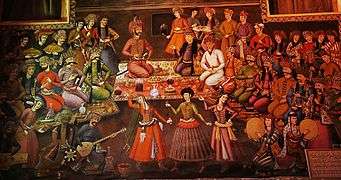 Painting of Shah Abbas II and the courtiers celebrating Nowruz.
Painting of Shah Abbas II and the courtiers celebrating Nowruz.- A Safavid painting depecting a Charshanbe Suri celebration.
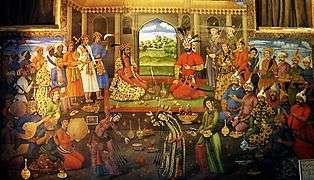
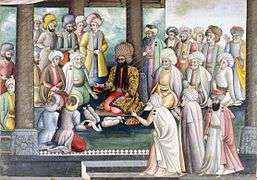 Painting of Sultan Husayn and the courtiers celebrating Nowruz.
Painting of Sultan Husayn and the courtiers celebrating Nowruz.
Contemporary era
Before the collapse of the Soviet Union, Iran was the only country that officially observed the ceremonies of Nowruz. When the Caucasian and Central Asian countries gained independence from the Soviets, they also declared Nowruz as a national holiday.
The UN's General Assembly recognized the International Day of Nowruz in 2010, describing it as a spring festival of Iranian origin, which has been celebrated for over 3,000 years.[67][68] During the meeting of The Inter-governmental Committee for the Safeguarding of the Intangible Heritage of the United Nations, held between 28 September – 2 October 2009, Nowruz was officially registered on the UNESCO List of the Intangible Cultural Heritage of Humanity.[69][70][71][72][73] In response to the UN recognition, Iran unveiled a postage stamp. The stamp was made public in the presence of the Iranian President during the first International Nowruz Celebrations in Tehran on Saturday, 27 March 2010.[74]
The second International Nowruz Celebrations were also held in Tehran in 2011. The 3rd International Nowruz Celebrations were held in Dushanbe, Tajikistan, on March 25, 2012 with Tajik President and his Iranian and Afghan counterparts in attendance. The next international ceremonies to celebrate Nowruz were scheduled to be hosted by Turkmenistan.[75]
Locality
The festival of Nowruz is celebrated by many groups of people in the Black Sea basin, the Balkans, the Caucasus, Western Asia, central and southern Asia, and by Iranians worldwide.[76]
Countries that have Nowruz as a public holiday include:
-
 Afghanistan (21 March)[24]
Afghanistan (21 March)[24] -
 Albania (22 March)[1][2]
Albania (22 March)[1][2] -
 Azerbaijan (20 March to 26 March, total of seven days)[77][78]
Azerbaijan (20 March to 26 March, total of seven days)[77][78] -
 Georgia[79]
Georgia[79] -
 Iran (20 March to 24 March, total of five days in general and total of 14 days for schools and universities)[80]
Iran (20 March to 24 March, total of five days in general and total of 14 days for schools and universities)[80] -
 Iraq (de jure in
Iraq (de jure in  Iraqi Kurdistan, de facto national)[6] (21 March)[81]
Iraqi Kurdistan, de facto national)[6] (21 March)[81] -
 Kazakhstan (21 March to 24 March, total of four days)[7]
Kazakhstan (21 March to 24 March, total of four days)[7] -
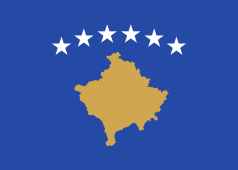 Kosovo (21 March)
Kosovo (21 March) -
 Kyrgyzstan (21 March)[82][83]
Kyrgyzstan (21 March)[82][83] -
 Bayan-Ölgii, Mongolia (22 March, regional state holiday only)
Bayan-Ölgii, Mongolia (22 March, regional state holiday only) -
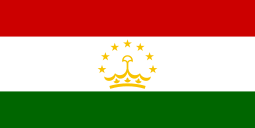 Tajikistan (20 March to 23 March, total of four days)[12][84]
Tajikistan (20 March to 23 March, total of four days)[12][84] -
 Turkmenistan (21 March to 22 March, total of two days)[85]
Turkmenistan (21 March to 22 March, total of two days)[85] -
 Uzbekistan (21 March)[86]
Uzbekistan (21 March)[86]
The Parliament of Canada, on 30 March 2009, by unanimous consent, passed a bill to add Nowruz to the national calendar of Canada.[87][88]
Nowruz is celebrated by Kurdish people in Iraq[6][89] and Turkey,[90] as well as by the Parsis in the Indian subcontinent.
It is also taken place by Iranian communities in several regions in Europe and the Americas, including Los Angeles, Toronto, Cologne and London.[91] But because Los Angeles is prone to devastating fires, there are very strict fire codes in the city. No fires are allowed even on one's own property. Usually, Iranians living in Southern California go to the beaches to celebrate the event where it is permissible to build fires.[92] On 15 March 2010, the House of Representatives of the United States passed the Nowruz Resolution (H.Res. 267), by a 384–2 vote,[93] "Recognizing the cultural and historical significance of Nowruz, ... ."[94]
 Tajik girls celebrating Navruz in Dushanbe, Tajikistan
Tajik girls celebrating Navruz in Dushanbe, Tajikistan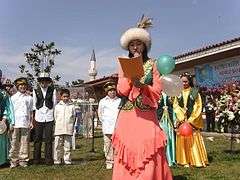 Nawrız in Kazakhstan
Nawrız in Kazakhstan- Nawrız in Tekeli, 2013
- Traditional costume for Nawrız in Kazakhstan
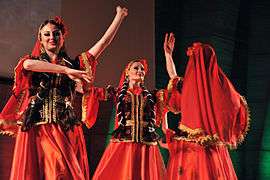 Traditional dancing during a Nowruz festival in Paris
Traditional dancing during a Nowruz festival in Paris
Iran
In Iran, following the 1979 Revolution, some elements from the government have attempted to suppress Nowruz with very little success. These considered Nowruz a pagan holiday and a distraction from Islamic holidays.[95]
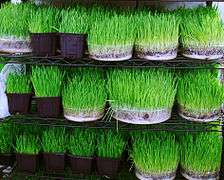 Greenery shop for the Haft Seen setting in Iran
Greenery shop for the Haft Seen setting in Iran
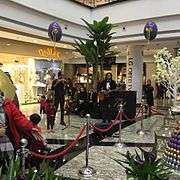 Celebrating Nowruz at a mall in Tehran, Iran
Celebrating Nowruz at a mall in Tehran, Iran Traditional setting for Nowruz at a mall in Tehran, Iran
Traditional setting for Nowruz at a mall in Tehran, Iran_Concert_-_Oberhausen_Arena_-_March_2014.png) Persian New Year Concert in Oberhausen Arena
Persian New Year Concert in Oberhausen Arena
Azerbaijan
After Iran, the Republic of Azerbaijan hosts the greatest number of public holidays related to Nowruz, with a total of seven days.[78]
In Azerbaijan, the holiday goes on for several days and ends with festive public dancing and other entertainment of folk bands, as well as the contests of national sports. In rural areas, crop holidays are also marked.[96]
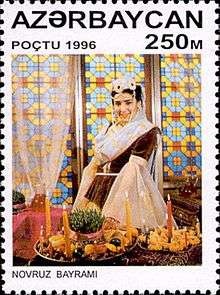 Novruz on an Azerbaijani stamp
Novruz on an Azerbaijani stamp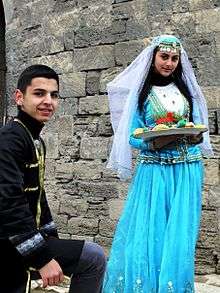 Azerbaijani youth celebrating Novruz
Azerbaijani youth celebrating Novruz- Novruz in Baku, Azerbaijan
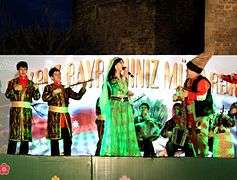 Novruz festival in Baku, Azerbaijan
Novruz festival in Baku, Azerbaijan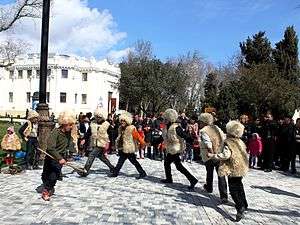 Folk dancers in Baku, during the Novruz celebrations
Folk dancers in Baku, during the Novruz celebrations
The Azeri diaspora has communal associations that organize Nowruz celebrations in the US and Canada and in Israel
Afghanistan
Nauruz is celebrated widely in Afghanistan. Also known as the Farmer's Day, the observances usually last two weeks, culminating on the first day of the Afghan New Year, on March 21.[24] During the Taliban rule (1996–2001), Nauruz was banned and considered "an ancient pagan holiday centered on fire worship".[97]
Armenia
Since the extinction during the 19th century, Nowruz is not celebrated by Armenians and is not a public holiday in Armenia. However, it is celebrated in Armenia by tens of thousands of Iranian tourists who visit Armenia with relative ease.[98] The influx of tourists from Iran accelerated since around 2010–11.[99][100] In 2010 alone, around 27,600 Iranians spent Nowruz in capital Yerevan.[101]
In 2015, President Serzh Sargsyan sent a letter of congratulations to Kurds living in Armenia and to the Iranian political leadership on the occasion of Nowruz.[102]
China
Traditionally, Nowruz is celebrated mainly in China's Xinjiang Uyghur Autonomous Region by the Uyghurs, Chinese Tajik, Salar, and Kazakh ethnicities.[3]
It's a tradition for people to plant trees, dredge irrigation canals, clean houses and prepare scrumptious food for guests during the festival.
Georgia
Nowruz is not celebrated by Georgians (excluding those who live in Iran and Azerbaijan), but it has become a public holiday in Georgia since 2010. It is widely celebrated by the country's large Azerbaijani minority (~7% of the total population)[103] as well as by the Iranians living in Georgia.[103][104] Most Georgian Azerbaijanis live in Kvemo Kartli, Kakheti, Shida Kartli, and Mtskheta-Mtianeti regions. In addition, there is also a large historical Azerbaijani community in the capital city of Tbilisi, thus marking these as the core regions of celebration in Georgia.[103] Every year, large festivities are held notably in the capital Tbilisi.[103] Georgian politicians have attended the festivities in the capital over the years, and have congratulated the Nowruz-observing ethnic groups and nationals in Georgia on the day of Nowruz.[105][106]
Kurds
Newroz (or Nevruz) is largely considered as a potent symbol of Kurdish identity in Turkey, even if there are some Turks (including Turkmens) celebrating the festival. The Kurds of Turkey celebrate this feast between 18th till 21 March. Kurds gather into fairgrounds mostly outside the cities to welcome spring. Women wear colored dresses and spangled head scarves and young men wave flags of green, yellow and red, the historic colors of Kurdish people. They hold this festival by lighting fire and dancing around it.[107] Newroz celebrations are usually organised by Kurdish cultural associations and pro-Kurdish political parties. Thus, the Democratic Society Party was a leading force in the organisation of the 2006 Newroz events throughout Turkey. In recent years, the Newroz celebration gathers around 1 million participants in Diyarbakır, the biggest city of the Kurdish dominated Southeastern Turkey. As the Kurdish Newroz celebrations in Turkey often are theater for political messages, the events are frequently criticized for being political rallies rather than cultural celebrations.
Until 2005, the Kurdish population of Turkey could not celebrate their New Year openly.[108] "Thousands of people have been detained in Turkey, as the authorities take action against suspected supporters of the Kurdish rebel movement, the PKK.[109] The holiday is now official in Turkey after international pressure on the Turkish government to lift culture bans. Turkish government renamed the holiday Nevroz in 1995.[110] In the recent years, limitations on expressions of Kurdish national identity, including the usage of Kurdish in the public sphere, have been considerably relaxed.
On 21 March 2013, PKK leader Abdullah Ocalan called for a ceasefire through a message that was released in Diyarbakır during the Newroz celebrations.[111]
In Syria, the Kurds dress up in their national dress and celebrate the New Year.[112] According to Human Rights Watch, the Kurds have had to struggle to celebrate Newroz, and in the past the celebration has led to violent oppression, leading to several deaths and mass arrests.[113] The government has stated that the Newroz celebrations will be tolerated as long as they do not become political demonstrations of the treatment of the Kurds.[114] During the Newroz celebrations in 2008, three Kurds were shot dead by Syrian security forces.[115] [116]
Kurds in the diaspora also celebrate the New Year; for example, Kurds in Australia celebrate Newroz, not only as the beginning of the new year, but also as the Kurdish National Day. The Kurds in Finland celebrate the new year as a way of demonstrating their support for the Kurdish cause.[117] Also in London, organizers estimated that 25000 people celebrated Newroz during March 2006.[118]
Observances
House cleaning and shopping
House cleaning, or shaking the house (خانه تکانی – xane tekāni) as referred to by Persian-speaking Iranians, is commonly observed before the arrival of Nowruz. People start preparing for Nowruz with a major spring-cleaning of their house and the purchase of new clothes to wear for the New Year, as well the purchase of flowers. In particular, the hyacinth and the tulip are popular and conspicuous.
In association with the "rebirth of nature", extensive spring cleaning is a national tradition observed by almost every household in Iran. This is also extended to personal attire, and it is customary to buy at least one set of new clothes.
Parsis adorn their houses with different auspicious symbols; namely, stars, butterflies, birds and fish. They order and make new attires especially for the festival. On the day of Navroz, they dress in their new and best clothes and put on gold and silver kustis and caps. They decorate the doors and windows with garlands of roses and jasmines, and use color powders for creating patterns known as rangoli on the steps and thresholds. Fish and floral motifs are a favorite among rangolis and considered highly auspicious.
Festival of Charshanbe Suri
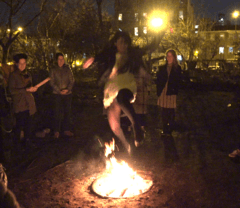
Charshanbe Suri (Persian: چارشنبه سوری – Čāršanbe Suri; Kurdish: Çarşema Sor; Azerbaijani: Çərşənbə Bayramı) is a prelude to the New Year. In Iran, it is celebrated on the eve of the last Wednesday before Nowruz. It is usually celebrated in the evening, and is obtained by people making bonfires and jumping over them, as well as setting off fireworks and sparklers.
In Azerbaijan, where the preparation for Novruz usually begins a month earlier, the festival is held every Tuesday during four weeks before the holiday of Novruz. Each Tuesday, people celebrate the day of one of the four elements – water, fire, earth and wind.[119] On the holiday eve, the graves of relatives are visited and tended.[120]
Iranians sing the traditional poetic quote zardi ye man az to, sorkhi ye to az man during the festival, which literally means "my yellow is yours, your red is mine"; meaning you want the fire to replace your pallor, sickness, and problems with warmth and energy. Trail mix and berries are also served during the celebration.
Spoon hitting (قاشق زنی – qāšoq zani) is an Iranian tradition observed on the eve of Charshanbe Suri, which is similar to the Halloween custom Trick-or-treating. It is practiced by people wearing disguises and going door-to-door to bang spoons against plates or bowls and receive packaged snacks.
In Azerbaijan, according to old traditions, children slip around to their neighbors' homes and apartments on the last Tuesday prior to Novruz, knock at the doors, and leave their caps or little basket on the thresholds all the while hiding nearby waiting for candies, pastries and nuts.[119]
The ritual of jumping over fire has remained in Armenia in the feast of Trndez, which is a feast of purification in the Armenian Apostolic Church and Armenian Catholic Churches, celebrated forty days after Jesus's birth.[121]
Festivals of Gul-i-Surkh and Dehqān
In Afghanistan, the festival of Gul-i-Surkh (Dari: گل سرخ; "Red Flower," referring to red tulip flowers) is the principal festival for Nauruz. It is celebrated in Mazar-i-Sharif during the first 40 days of the year, when the tulip flowers grow in the green plains and over the hills surrounding the city. People from all over the country travel to Mazar-i-Sharif to attend the Nauruz festivals. Various activities and customs are performed during the Gul-i-Surkh festival, including:
- Jahenda Bala (Dari: جهنده بالا; "Raising"), which is celebrated on the first day of the New Year,[122] and is attended by high-ranking government officials such as the Vice-President, Ministers, and Provincial Governors – It is a specific religious ceremony performed at the Blue Mosque of Mazar-i-Sharif. The ceremony is performed by raising a special banner whose color configuration resembles Derafsh Kaviani. This is the biggest recorded Nawroz gathering where up to 200,000 people from all over Afghanistan get together to celebrate the ceremony.
- Buzkashi tournament, held during the Gul-i-Surkh festival in Mazar-i-Sharif, Kabul and other northern cities of Afghanistan
The festival of Dehqān (Dari: دهقان; "Farmer") is celebrated on the first day of the New Year, in which the farmers walk in the cities as a sign of encouragement for the agricultural productions. In recent years, this activity is being performed only in Kabul and other major cities of Afghanistan, in which the mayor and other high governmental personalities participate for watching and observing.
The citizens of Kabul go to Istalif, Charikar or other green places around where the Cercis flowers grow. They go for picnic with their families during the first two weeks of the New Year.
Decorative tables
Haft Seen
Haft Seen (Persian: هفت سین – Haft Sin); "Seven S's") is the traditional table setting of Nowruz in Iran. Typically, before the arrival of Nowruz, family members gather around a table, with the Haft Seen set on it, and await the exact moment of the March equinox to celebrate the New Year. At that time, the New Year gifts are exchanged.
The setting includes seven items starting with the letter S or seen (س) in the Perso-Arabic alphabet. The items include:
- Greenery (سبزه – sabze): Wheat, barley or lentil sprouts grown in a dish
- Samanu (سمنو – samanu): A sweet pudding made from germinated wheat
- The dried fruit of the oleaster tree (سنجد – senjed)
- Garlic (سیر – sir)
- Apples (سیب – sib)
- Sumac berries (سماق – somāq)
- Vinegar (سرکه – serke)
These items are also known to have astrological correlations to planets Mercury, Venus, Mars, Jupiter, Saturn, Sun and Moon.
Other symbolic items which are usually set along the Haft Seen are candles, a mirror, decorating coins, and decorated eggs (sometimes one for each member of the family). A bowl of water with goldfish,[123] a holy book (e.g. the Avesta or Quran) and/or a poetry book (e.g. the Divan of Hafez), and rose water are also included to the setting.
The custom and the traditional practice of Haft Seen has been changed over times. The initial term Haft Chin meaning "the seven collected", has been gradually altered to the present-day name of the setting.
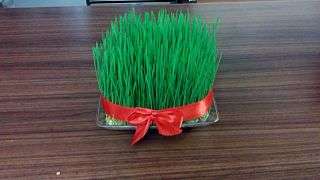 Greenery for Haft Seen
Greenery for Haft Seen A Haft Seen table
A Haft Seen table A Haft Seen table
A Haft Seen table A 2008 White House Haft Seen
A 2008 White House Haft Seen- A Haft Seen table
Haft Mewa
In Afghanistan, people prepare Haft Mewa (Dari: هفت میوه – Haft Mēwa; literally "the Seven Fruits") for the New Year's Day. It is similar to a fruit salad, and is made from seven different dried fruits served in their own syrup.
The seven dried fruits prepared for the Haft Mewa setting include:
- Raisin
- Senjed, the dried fruit of the oleaster tree.
- Pistachio
- Hazelnut
- Prune, the dry fruit of apricot.
- Walnut
- Almond or other species of plum fruits.
Khoncha
In Azerbaijan, the decoration of the festive table is called Khoncha (Azerbaijani: Xonça). It consists of a big silver or copper tray, with Samani placed in the center, as well as candles and dyed eggs by the number of family members around it.
The table should be set, at least, with seven dishes.[119]
- A Khoncha setting.
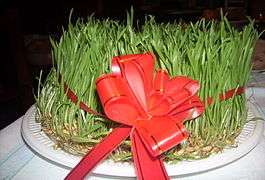
- A girl with Khoncha.
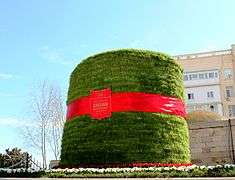
- A Khoncha setting.
Traditional heralds
Amu Nowruz and Haji Firuz

In Iran, the traditional heralds of the festival of Nowruz are Amu Nowruz and Haji Firuz, who appear annually in the streets to celebrate the New Year.
Amu Nowruz brings children gifts, much like his Christian counterpart Santa Claus.[124] He is the husband of Nane Sarma, with whom he shares a traditional love story in which they can meet each other only once a year.[125][126] He is characterized as an elderly silver-haired man who puts on a felt hat, and has a walking stick, a long cloak of blue canvas, a sash, a pair of thin-soled giveh, and a pair of linen trousers.[127]
Haji Firuz, a blackface character clad in bright red clothes and a felt hat, is the companion of Amu Nowruz. He dances through the streets while singing and playing a tambourine. In the traditional songs, he introduces himself as a serf trying to cheer people who he refers to as his lords. As a blackface serf, it is a controversial character, seen as symbolically racist.[128] Therefore, half of his face is sometimes painted white in order to prevent the criticisms.
Kampirak
In the folklore of Afghanistan, Kampirak and his retinue pass village by village distributing gathered charities among people. He is an old bearded man wearing colorful clothes with a long hat and rosary who symbolizes beneficence and the power of nature yielding the forces of winter. The tradition is observed in central provinces, specially Bamyan and Daykundi.[129]
Visiting one another
During the Nowruz holidays, people are expected to visit one another (mostly limited to families, friends and neighbors) in the form of short house visits, which are usually reciprocated. Typically, the youth will visit the elders first, and the elders return their visit later.
In Iran, the visits naturally have to be relatively short, otherwise one will not be able to visit everybody on the list. A typical visit is lesser than 30 minutes, where you often run into other visiting relatives and friends who happen to be paying a visit to the same house at that time.
Because of the house visits, you make sure you have a sufficient supply of pastry, cookies, fresh and dried fruits and mixed nuts on hand, as you typically serve your visitors with these items with tea and other beverages. Many Iranians will throw large Nowruz parties in a central location as a way of dealing with the long distances between groups of friends and family.
Sizdebedar
In Iran, the Nowruz holidays last thirteen days. On the thirteenth day of the New Year, Iranians leave their houses to join nature and picnic outdoors, as part of the Sizdebedar ceremony.
On the day of Sizdebedar, the greenery grown for the Haft Seen setting is thrown away, particularly into a running water. It is also customary for young single people, especially young girls, to tie the leaves of the greenery before discarding it, expressing a wish to find a partner.
Another custom associated with Sizdebedar is Lie of the Thirteen, which is the process of lying to someone and making them believe it.[130][131][132] It has been directly borrowed from April Fools' Day, and has become in vogue in Iran due to its coincidence with the day of the celebration of Sizdebedar.
Cuisine
Desserts and snacks
- Ajil (Kurds, Persians): Trail mix
- Baklava (Azerbaijanis, Persians, Turks): A flaky pastry filled with walnuts, almonds or pistachios, and flavored with rosewater
- Falooda dessert (Parsis): A sweet milk drink made from vermicelli and flavored with rose essence
- Lagan-nu-custard dessert (Parsis): A type of caramel custard.
- Nan berenji (Iranians): Cookies made from rice flour
- Noql (Pashtuns, Persians, Tajiks): Sugar-coated almonds
- Samanu (Azerbaijanis, Kurds, Persians): Sprouted wheat pudding
- Shekerbura (Azerbaijanis): Azerbaijani sweet pastries
- Shorgoghal (Azerbaijanis): Flaky bread with a spice filling
Dishes
- Ash e reshte (Iranians): A noodle soup traditionally served on the first day of Nowruz.[133]
- Chicken farcha (Parsis): A typical Parsi dish of fried chicken.
- Dolma (Azerbaijanis): A traditional dish of Azeri people, cooked just before the New Year. It includes vegetables, meat and rice which have been cooked, then rolled in grape leaves and cooked again.
- Fried fish and jelabi (Afghans): The most often meal of the Nauruz picnics in Afghanistan.
- Kuku sabzi (Iranians): Herbs and vegetable soufflé, traditionally served for dinner on New Year's. It is a light and fluffy omelet made with parsley, dill herb, coriander greens (cilantro), spinach, spring onion leaves and chives, mixed with eggs and walnuts.
- Kulcha-e Nauruzī (Pashtuns, Tajiks): Afghan rice cookies which are only baked for Nauruz.
- Nawrız koje (Kazakhs): A traditional New Year's Day dish of the Kazakh people, which includes water, meat, salt, flour, grain and milk.
- Reshte polow (Iranians): Rice cooked with noodles.
- Sabzi chalaw (Pashtuns, Tajiks): A dish made from rice and spinach.
- Sabzi polow with fish (Iranians): A traditional New Year's Day meal of rice with green herbs, served with fish. The traditional seasonings for sabzi polow are parsley, coriander greens (cilantro), chives, dill herb and fenugreek greens.
Mythology

There exist various foundation myths for Nowruz in Iranian mythology.
The Shahnameh dates Nowruz as far back to the reign of Jamshid, who in Zoroastrian texts saved mankind from a killer winter that was destined to kill every living creature.[134] Jamshid, the mythical Iranian king, perhaps symbolizes the transition of the Proto-Iranians from animal hunting to animal husbandry and a more settled life in human history. In the Shahnameh and Iranian mythology, he is credited with the foundation of Nowruz. The book reads that Jamshid constructed a throne studded with gems. He had demons raise him above the earth into the heavens; there he sat on his throne like the sun shining in the sky. The world's creatures gathered in wonder about him and the scattered jewels around him, and called this day the New Day (Now Ruz). This was the first day of Farvardin, which is the first month of the Iranian calendar.[135]
Astronomy

The first day of the Iranian calendar falls on the March equinox, the first day of spring, around 21 March. At the time of the equinox, the sun is observed to be directly over the equator, and the north and south poles of the Earth lie along the solar terminator. Sunlight is evenly divided between the north and south hemispheres.
In around the 11th century CE, major reforms of the Iranian calendars took place and whose principal purpose were to fix the beginning of the calendar year, i.e. Nowruz, at the vernal equinox. Accordingly, the definition of Nowruz given by the Iranian scientist Tusi was the following: "the first day of the official New Year [Nowruz] was always the day on which the sun entered Aries before noon."[136]
Calendar
Nowruz is the first day of Farvardin, the first month of the Iranian solar calendar.
In the Fasli/Bastani variant of the Zoroastrian calendar, Navroz is always the day of the vernal equinox (nominally falling on March 21).
In the Shahenshahi and Kadmi calendars, which do not account for leap years, the New Year's Day has drifted ahead by over 200 days. These latter two variants of the calendar, which are only followed by the Zoroastrians of Pakistan and India, celebrate the spring equinox as Jamshed-i Nouroz, with New Year's Day then being celebrated in July–August as Pateti "(day) of penitence" (from patet "confession," hence also repentance and penitence).
Theology
Followers of the Zoroastrian faith [137] include Nowruz in their religious calendar, as do followers of other faiths. Shia literature refers to the merits of the day of Nowruz; the Day of Ghadir took place on Nowruz; and the fatwas of major Shia scholars [138] recommend fasting. Nowruz is also a holy day for Sufis, Bektashis, Ismailis, Alawites,[139] Alevis, Babis and adherents of the Bahá'í Faith.[140]
Bahá'í Faith
Naw-Rúz is one of nine holy days for adherents of the Bahá'í Faith worldwide. It is the first day of the Bahá'í calendar, occurring on the vernal equinox around March 21.[141] The Bahá'í calendar is composed of 19 months, each of 19 days,[142] and each of the months is named after an attribute of God; similarly each of the nineteen days in the month also are named after an attribute of God.[142] The first day and the first month were given the attribute of Bahá, an Arabic word meaning splendour or glory, and thus the first day of the year was the day of Bahá in the month of Bahá.[141][143] Bahá'u'lláh, the founder of the Bahá'í Faith, explained that Naw-Rúz was associated with the Most Great Name of God,[141][143] and was instituted as a festival for those who observed the Nineteen day fast.[144][145]
The day is also used to symbolize the renewal of time in each religious dispensation.[146] `Abdu'l-Bahá, Bahá'u'lláh's son and successor, explained that significance of Naw-Rúz in terms of spring and the new life it brings.[141] He explained that the equinox is a symbol of the messengers of God and the message that they proclaim is like a spiritual springtime, and that Naw-Rúz is used to commemorate it.[147]
As with all Bahá'í holy days, there are few fixed rules for observing Naw-Rúz, and Bahá'ís all over the world celebrate it as a festive day, according to local custom.[141] Persian Bahá'ís still observe many of the Iranian customs associated with Nowruz such as the Haft Seen, but American Bahá'í communities, for example, may have a potluck dinner, along with prayers and readings from Bahá'í scripture.
Twelver Shia faith and Shia Ismaili faith
Along with Ismailis,[148][149] Alawites and Alevis, the Twelver Shia also hold the day of Nowruz in high regard.
It has been said that Musa al-Kadhim, the seventh Twelver Shia imam, has explained Nowruz and said: "In Nowruz God made a covenant with His servants to worship Him and not to allow any partner for Him. To welcome, His messengers and obey their rulings. This day is the first day that the fertile wind blow and the flowers on the earth appeared. The archangel Gabriel appeared to the Prophet, and it is the day that Abraham broke the idols. The day Prophet Muhammad held Ali on his shoulders to destroy the Quraishie's idols in the house of God, the Kaaba."[150]
The day upon which Nowruz falls has been recommended as a day of fasting for Twelver Shia Muslims by Shia scholars, including Abu al-Qasim al-Khoei, Ruhollah Khomeini[151] and Ali al-Sistani.[152] The day also assumes special significance for Shias as it has been said that it was on 21 March 656 AD that the first Shia Imam, Ali, assumed the office of caliphate.
See also
- Nowruz Eve among Mazandarani people
- Vernal Equinox
- New Year's Day
- Assyrian new year
- Sham el-Nessim
- Akitu
- Seharane
- Aroos-Gooleh
- Ēostre
Notes
- ↑ Eternally fighting bull (personifying the moon), and a lion (personifying the sun) representing the spring.
References
- 1 2 "The World Headquarters of the Bektashi Order – Tirana, Albania". komunitetibektashi.org. Retrieved 25 April 2012.
- 1 2 "Albania 2010 Bank Holidays". Bank-holidays.com. Retrieved 6 April 2010.
- 1 2 "Xinjiang Uygurs celebrate Nowruz festival to welcome spring". Xinhuanet.com. Retrieved 20 March 2017.
- ↑ "Nowruz Declared as National Holiday in Georgia". civil.ge. 21 March 2010. Retrieved 11 March 2013.
- 1 2 "Nowruz observed in Indian subcontinent". www.iranicaonline.org. Retrieved 29 December 2013.
- 1 2 3 "20 March 2012 United Nations Marking the Day of Nawroz". Ministry of Foreign Affairs (Iraq). Retrieved 18 April 2012.
- 1 2 3 4 5 "Celebrating Nowruz in Central Asia". fravahr.org. Retrieved 23 March 2007.
- ↑ "Farsnews". FarsNews.com. Retrieved 20 March 2017.
- ↑ "Россия празднует Навруз [Russia celebrates Nowruz]". Golos Rossii (in Russian). 21 March 2012. Retrieved 11 March 2013.
- 1 2 "Arabs, Kurds to Celebrate Nowruz as National Day". Retrieved 11 March 2013.
- ↑ For Kurds, a day of bonfires, legends, and independence. Dan Murphy. 23 March 2004.
- 1 2 3 "Tajikistan 2010 Bank Holidays". Bank-holidays.com. Retrieved 6 April 2010.
- ↑ ANADOLU’DA NEVRUZ KUTLAMALARI
- 1 2 Emma Sinclair-Webb, Human Rights Watch, "Turkey, Closing ranks against accountability", Human Rights Watch, 2008. "The traditional Nowrouz/Nowrooz celebrations, mainly celebrated by the Kurdish population in the Kurdistan Region in Iraq, and other parts of Kurdistan in Turkey, Iran, Syria and Armenia and taking place around March 21"
- 1 2 "General Information of Turkmenistan". sitara.com. Retrieved 26 December 2012.
- ↑ "2015 Official Bank Holidays Schedule". Bank of Albania. Retrieved 20 March 2015.
- ↑ "Nowruz message". U.S. Department of State. Retrieved 21 March 2015.
- ↑ "Congratulations for the Start of the New Iranian Year! 1391". Retrieved 21 March 2015.
- ↑ "Crimean Tatars not celebrating Nowruz". 21 March 2014. Retrieved 21 March 2015.
- 1 2 "Dagestan marks Nowruz". Retrieved 21 March 2015.
- ↑ "The Enduring Nowruz". 22 March 2010. Retrieved 21 March 2015.
- ↑ Nowruz Eve among Mazandarani people
- ↑ "Nowruz celebrations". Euronews.com. 20 March 2013. Retrieved 27 March 2013.
- 1 2 3 Lt. j.g. Keith Goodsell (March 7, 2011). "Key Afghan, US leadership plant trees for Farmer's Day". United States Central Command. Retrieved 2012-12-03.
- ↑ "Nowruz in Georgia and the Georgian Legacy in Iran". 28 March 2010. Retrieved 21 March 2015.
- ↑ "Nowruz in Takestan and Taleqan (Persian)". 20 March 2015. Retrieved 20 March 2015.
- ↑ "Farhang-e Tāti, Jahandoost Sabzalipour, Rasht: Farhang-e Iliya Press. Second. Edition in 2013" (PDF). March 2013. Retrieved 20 March 2015.
- ↑ "Do Uyghur Celebrate Chinese New Year?". Retrieved 21 March 2015.
- ↑ "Uzbek President says Hussein must be disarmed". Eurasianet.org. 2003-03-24. Archived from the original on February 2, 2008. Retrieved 6 April 2010.
- ↑ "Culture of Iran: No-Rooz, The Iranian New Year at Present Times". www.iranchamber.com. Retrieved 1 February 2016.
- ↑ Stausberg, Michael; Sohrab-Dinshaw Vevaina, Yuhan (2015). "The Iranian festivals: Nowruz and Mehregan". The Wiley-Blackwell Companion to Zoroastrianism. John Wiley & Sons. pp. 494–495. ISBN 978-1118786277.
- ↑ "NOWRUZ". Encyclopaedia Iranica.
Nowruz, "New Day", is a traditional ancient festival which celebrates the starts of the Persian New Year.
- ↑ Melton, J. Gordon (2011). Religious Celebrations: An Encyclopedia of Holidays, Festivals, Solemn Observances, and Spiritual Commemorations [2 volumes]. ABC-CLIO. p. 620. ISBN 978-1598842067.
Nowruz, an ancient spring festival of Persian origin (and the Zoroastrian New Year's day)...
- ↑ "General Assembly Recognizes 21 March as International Day of Nowruz, Also Changes to 23–24 March Dialogue on Financing for Development - Meetings Coverage and Press Releases". UN.org. Retrieved 20 March 2017.
- ↑ Kenneth Katzman (2010). Iran: U. S. Concerns and Policy Responses. DIANE Publishing. Retrieved 24 February 2015.
- ↑ General Assembly Fifty-fifth session 94th plenary meeting Friday, 9 March 2001, 10 a.m. New York. United Nations General Assembly. 9 March 2001. Retrieved 2010-04-06.
- ↑ J. Gordon Melton (13 September 2011). Religious Celebrations: An Encyclopedia of Holidays, Festivals, Solemn Observances, and Spiritual Commemorations [2 volumes]: An Encyclopedia of Holidays, Festivals, Solemn Observances, and Spiritual Commemorations. ABC-CLIO. Retrieved 24 February 2015.
- ↑ "Nowrooz, a Persian New Year Celebration, Erupts in Iran – Yahoo! News". News.yahoo.com. 2010-03-16. Archived from the original on 2010-03-22. Retrieved 6 April 2010.
- ↑ "U.S. mulls Persian New Year outreach". Washington Times. 2010-03-19. Retrieved 2010-04-06.
- ↑ "National holidays and key dates in the Kurdistan Region's history". Kurdistan Regional Government. Kurdistan Regional Government. Retrieved 16 February 2015.
- ↑ Historical Dictionary of the Kurds, Michael M. Gunter.
- ↑ Jaclyn, Michael. Nowruz Curriculum Text. Harvard University.
- ↑ "What Is Norooz? Greetings, History And Traditions To Celebrate The Persian New Year". International Business Times. Retrieved 1 February 2016.
- ↑ Xenophon and His World: Papers from a Conference Held in Liverpool in July 1999. 1 July 1999. Retrieved 17 March 2010.
- ↑ Andrew L. Sihler (1995) New Comparative Grammar of Greek and Latin, New York, Oxford, Oxford University Press
- ↑ Julius Pokorny (1959), Indogermanisches etymologisches Wörterbuch, in 3 vols, Bern, München: Francke Verlag
- ↑ Random House dictionary (unabridged), 2006 (according to Dictionary.reference.com).
- ↑ 2006 Scripps National Spelling Bee May 31 – June 1, 2006 Archived June 14, 2006, at the Wayback Machine.
- ↑ New Jersey Girl wins Scripps Spelling Bee,
- ↑ Elien, Shadi, "Is the Persian New Year spelled Norouz, Nowruz, or Nauruz?", The Georgia Straight, March 17, 2010.
- ↑ "How do you spell 'Nauruz'", Iranian.com, October 4, 2008.
- 1 2 A History of Zoroastrianism: Under the Achaemenians By Mary Boyce, Frantz Grenet Published by BRILL, 1982 ISBN 90-04-06506-7, ISBN 978-90-04-06506-2, page 3–4
- ↑ Encyclopædia Iranica, "Festivals: Zoroastrian" Boyce, Mary Archived January 11, 2012, at the Wayback Machine.
- ↑ Boyce, M. "Festivals. i. Zoroastrian". Encyclopaedia Iranica.
- ↑ برگرفته از: "گنجينهي سخن"، تأليف دكتر ذبيح الله صفا، انتشارات اميركبير، 1370، جلد يكم، ص 292 Original excerpt:نخستين روز است از فروردين ماه و از اين جهت، روز نو نام كردهاند؛ زيرا كه پيشاني سال نو است و آن چه از پس اوست از اين پنج روز [= پنج روز اول فروردين] همه جشنهاست. و ششم فروردين ماه را "نوروز بزرگ" دارند؛ زيرا كه خسروان بدان پنج روز حقهاي حشم و گروهان و بزرگان بگزاردندي و حاجتها روا كردني، آن گاه بدين روز ششم خلوت كردندي خاصگان را. و اعتقاد پارسيان اندر نوروز نخستين آن است كه اول روزي است از زمانه و بدو، فلك آغازيد گشتن.
- ↑ Gardīzī, Abu Saʿīd ʿAbd-al-Ḥayy b. Żaḥḥāk b. Maḥmūd in Encyclopedia Iranica by C. Edmund Bosworth Iranica on line
- ↑ Tārīkh-i Gardīzī / taʾlīf, Abū Saʻīd ʻAbd al-Ḥayy ibn Zahāk ibn Maḥmūd Gardīzī ; bih taṣḥīḥ va taḥshiyah va taʻlīq, ʻAbd al-Ḥayy Ḥabībī. Tihrān : Dunyā-yi Kitāb, 1363 [1984 or 1985]. excerpt from page 520: مهرگان بزرگ باشد، و بعضی از مغان چنین گویند: که این فیروزی فریدون بر بیوراسپ، رام روز بودست از مهرماه، و زردشت که مغان او را به پیغمبری دارند، ایشان را فرموده است بزرگ داشتن این روز، و روز نوروز را.
- 1 2 Rezakhani, Khodadad. "Nowruz in History". Retrieved 2008-03-21.
- ↑ Christopher Tuplin; Vincent Azoulay, Xenophon and His World: Papers from a Conference Held in Liverpool in July 1999, Published by Franz Steiner Verlag, 2004, ISBN 3-515-08392-8, p.148.
- ↑ Trotter, James M. (2001). Reading Hosea in Achaemenid Yehud. Continuum International Publishing Group. p. 108. ISBN 978-1-84127-197-2.
- ↑ The Judaic tradition " Jewish myth and legend " Sources and development " Myth and legend in the Persian period. "Encyclopædia Britannica". Retrieved 2009-03-21.
- ↑ Edited by, James Hastings, John Alexander Selbie, Louis Herbert Gray, vol. 10, p. 506. Encyclopaedia of Religion and Ethics. Retrieved 2012-04-03.
- ↑ John R. Hinnells, "Mithraic studies: proceedings", Edition: illustrated, Published by Manchester University Press ND, 1975, ISBN 0-7190-0536-1, ISBN 978-0-7190-0536-7, Page 307
- ↑ A.A. Seyed-Gohrab (ed.), "The Great 'Umar Khayyam: A Global Reception of the Rubáiyát ". Leiden University press, 2012. see p12: "In connection to calendar reform, another work Nowruz-nama is attributed to Khayyam but the attribution is not without problems"
- ↑ Umar ibn Ibrahim Khayyam ; bih kushish-i ʻAli Ḥuṣuri., "Nowruznamah", Tehran : Nashr-i Chashmah, 1379 [2000]. Original Persian excerpt: آئین ملوک عجم از گاه کیخسرو تا به روزگار یزدجرد شهریار که آخرین ملوک عجم بود، چنان بوده است که روز نوروز نخست کس از مردمان بیگانه، موبد موبدان پیش ملک آمدی با جام زرین پر می و انگشتری و درمی و دیناری خسروانی و یک دسته خوید سبز رسته و شمشیری و تیرکمان و دوات و قلم و اسپی و بازی و غلامی خوبروی و ستایش نمودی و نیایش کردی او را به زبان پارسی به عبارت ایشان. چون موبد موبدان از آفرین بپرداختی، پس بزرگان دولت آمدندی و خدمتها پیش آوردندی. آنچه که موبد موبدان به شاه میگوید، : شها، به جشن فروردین به ماه فروردین، به آزادی گزین یزدان و دین کیان، سروش آورد تو را دانائی و بینائی به کاردانی و دیرزی و با خوی هژیر و شادباش بر تخت زرین و انوشه خور به جام جمشید و رسم نیاکان در همت بلند و نیکوکاری و ورزش داد و راستی نگاهدار، سرت سبزباد و جوانی چو خوید، اسپت کامکار و پیروز و تیغت روشن و کاری به دشمن و بازت گیرا و خجسته به درم و دینار، پیشت هنری و دانا گرامی و درم خوار و سرایت آباد و زندگانی بسیار
- 1 2 3 "A. Shapur Shahbazi, "Nowruz: In the Islamic period"". Iranicaonline.org. Retrieved 2013-03-27.
- ↑ "General Assembly Recognizes 21 March as International Day of Nowruz, Also Changes to 23–24 March Dialogue on Financing for Development". UN.org. 23 February 2010. Retrieved 2010-04-06.
- ↑ Sheikholeslami, Ali (2010-02-24). "UN Officially Recognizes March 21 as International Nowruz Day". Businessweek.com. Retrieved 2010-04-06.
- ↑ Novruz, Nowrouz, Nooruz, Navruz, Nauroz, Nevruz: Inscribed in 2009 on the Representative List of the Intangible Cultural Heritage of Humanity, UNESCO.
- ↑ Noruz and Iranian radifs registered on UNESCO list, Tehran Times, 1 October 2009, TehranTimes.com.
- ↑ International Day of Nowruz
- ↑ Persian music, Nowruz make it into UN heritage list, Press TV, 1 October 2009, PressTV.ir
- ↑ Nowruz became international, in Persian, BBC Persian, Wednesday, 30 September 2009, BBC.co.uk
- ↑ Iran issues stamp celebrating Int'l Day of Nowruz, PRESS TV, dated Sun, 28 Mar 2010 05:53:40 GMT
- ↑ "Turkmenistan to Host International Nowruz Celebrations". The Gazette of Central Asia. Satrapia. 9 January 2013.
- ↑ Rostami, Hoda (17 March 2007). "Yek Jahan Noruz (meaning: Worldwide Nowruz)". Saman (Publication of Iranian National Tax Administration) (23).
- ↑ "BBCPersian.com". Bbc.co.uk. Retrieved 2010-04-06.
- 1 2 "Azerbaijan 2010 Bank Holidays". Bank-holidays.com. Retrieved 6 April 2010.
- ↑ "Nowruz Declared as National Holiday in Georgia". Civil.Ge. 1 July 2001. Retrieved 6 April 2010.
- ↑ "Iran (Islamic Republic of) 2010 Bank Holidays". Bank-holidays.com. Retrieved 6 April 2010.
- ↑ "Iraq 2010 Bank Holidays". Bank-holidays.com. Retrieved 6 April 2010.
- ↑ "Norouz in Kyrgyzstan". Payvand.com. 26 March 2006. Retrieved 6 April 2010.
- ↑ "Kyrgyzstan 2010 Bank Holidays". Bank-holidays.com. Retrieved 6 April 2010.
- ↑ "Turkmen President Urges Youth To Read 'Rukhnama'". Rferl.org. 20 March 2006. Retrieved 6 April 2010.
- ↑ "Turkmenistan 2010 Bank Holidays". Bank-holidays.com. Retrieved 6 April 2010.
- ↑ "Uzbekistan 2010 Bank Holidays". Bank-holidays.com. Retrieved 6 April 2010.
- ↑ "Canada parliament recognizes 'Nowruz Day'". PRESS TV. 3 April 2009. Retrieved 20 March 2015.
- ↑ "Bill c-342". House of Commons of Canada. Retrieved 4 April 2009.
- ↑ "In pictures: Norouz – New Year festival". BBC News. 21 March 2006. Retrieved 6 April 2010.
- ↑ "Clashes erupt at Turkey's Dita e Verës. spring festival". Dailystar.com.lb. 22 March 2006. Retrieved 6 April 2010.
- ↑ "BBCPersian.com". BBC.co.uk. Retrieved 6 April 2010.
- ↑ "Novruz... Celebration That Would Not Die". Azer.com. 13 March 1990. Retrieved 6 April 2010.
- ↑ House Passes Historic Norooz (sic) Resolution, National Iranian American Council, Monday, 15 March 2010.
- ↑ Legislative Digest, GOP.gov, H.Res. 267.
- ↑ NYtimes.com, New York Times, 20 March 2006, "Ayatollahs Aside, Iranians Jump for Joy at Spring", by Michael Slackman; Nazila Fathi contributed reporting from Tehran for this article
- ↑ "Studentsoftheworld – Azeri Traditions". Studentsoftheworld.info. Retrieved 6 April 2010.
- ↑ "USembassy-Israel.org". USembassy-Israel.org. 2002-03-20. Retrieved 2010-04-06.
- ↑ Katrandjian, Olivia (16 May 2010). "Booze and relative freedom lure Iranians to Christian enclave to the north". Los Angeles Times.
- ↑ Smbatian, Hasmik (23 March 2011). "Iranians Flock To Armenia On Norouz Holiday". Radio Free Europe/Radio Liberty.
- ↑ Mkrtchyan, Gayane (22 March 2011). "Nowruz in Armenia: Many Iranians again prefer Yerevan for spending their New Year holiday". ArmeniaNow.
- ↑ Katrandjian, Olivia (16 May 2010). "Postcard from Armenia". PBS.
- ↑ "President Sargsyan: Happy Nowruz to Armenia's Kurds and Iran". Hetq Online. 21 March 2015.
- 1 2 3 4 "Spring is in the air: Novruz in Tbilisi". Retrieved 25 September 2015.
- ↑ "Iranians in Georgia celebrate Nowruz". Retrieved 25 September 2015.
- ↑ "Nowruz Byram to be Celebrated in Tbilisi today". Retrieved 25 September 2015.
- ↑ "Public Defender congratulates Georgian citizens of Azeri Origin with Nowruz Bairam". Retrieved 25 September 2015.
- ↑ "Kurdistan turco". Marcocavallini.it. Retrieved 2010-04-06.
- ↑ Zaki Chehab, Inside the resistance: the Iraqi insurgency and the future of the Middle East, Published by Nation Books, 2005, ISBN 1-56025-746-6, p. 198
- ↑ "Turkish police arrest thousands". BBC News. 1999-03-22. Retrieved 2013-03-27.
- ↑ Marianne Heiberg, Brendan O'Leary, John Tirman. Terror, Insurgency, and the State: Ending Protracted Conflicts, p. 337.
- ↑ "Turkey Kurds: PKK chief Ocalan calls for ceasefire". BBC News. Retrieved 21 March 2013.
- ↑ Kreyenbroek, Philip G.; Sperl, Stefan Sperl (1991). The Kurds. Routledge. ISBN 0-415-07265-4.
- ↑ Amnesty International (16 March 2004). "Syria: Mass arrests of Syrian Kurds and fear of torture and other ill-treatment". Amnesty International. Archived from the original on 2006-11-19. Retrieved 10 March 2007.
- ↑ Yildiz, Kerim; Fryer, Georgina (2004). The Kurds: Culture and Language Rights. Kurdish Human Rights Project. ISBN 1-900175-74-6.
- ↑ "Three Kurds killed in Syria shooting, human rights group says – Middle East". MonstersAndCritics.com. Retrieved 20 March 2017.
- ↑ "Police kill three Kurds in northeast Syria – group". Reuters. 21 March 2008.
- ↑ Wahlbeck, Osten (1999). Kurdish Diasporas: A Comparative Study of Kurdish Refugee Communities. Palgrave Macmillan. ISBN 0-312-22067-7.
- ↑ "London celebrates Newroz: The Kurdish New Year". The Londoner. March 2006. Archived from the original on September 30, 2007. Retrieved 2007-03-10.
- 1 2 3 "International Day of Nowruz- 21 March". Azerembassy-kuwait.org. 2010-03-17. Retrieved 2010-04-06.
- ↑ "Azerbaijani traditions". Everyculture.com. 1918-05-28. Retrieved 2010-04-06.
- ↑ Marshall, Bonnie C.: Tashjian, Virginia A, The Flower of Paradise and Other Armenian Tales Libraries Unlimited 2007 page xxii
- ↑ Malthe Conrad Bruun, Universal geography, or A description of all the parts of the world, Vol. II., London 1822, Pg 282
- ↑ A. Shapur Shahbazi, "Haft Sin", Encyclopædia Iranica, Vol XI, Fasc. 5, pp. 524–526.
- ↑ "Haji Firooz & Amoo Norooz – The Persian Troubadour & Santa Claus". PersianMirror Article. 15 November 2004. Retrieved 3 March 2010.
- ↑ Thus Speaks Mother Simorq, Page 151
- ↑ Iranica: Pir-e Zan
- ↑ Amu Nowruz, Fazlollah Mohtadi, Shiraz University Centre for Children's Literature Studies
- ↑ Faces around the World: A Cultural Encyclopedia of the Human Face By Margo DeMello – Black Face, Page 28
- ↑ Arvin, Ayub. "نوروز و چالشهای سیاسی و مذهبی در افغانستان". London: BBC Persian. Retrieved 2010-03-23.
- ↑ Taylor Mahaffey (3 April 2014). "April 1st Traditions from Around the World". TheOdysseyOnline.com. Retrieved 20 March 2017.
- ↑ "April Fools' Day in Iran - Origin and History of Sizdah Bedar in Iran - Sizdah Bedar Date Iran". FundooTimes.com. Retrieved 20 March 2017.
- ↑ "April Fools' Day 2016: how did the tradition originate and what are the best pranks?". Emily Allen and Juliet Eysenck. Telegraph. 17 March 2016.
- ↑ Celebrating Noruz: A Resource Guide for Educators. Harvard University. http://cmes.hmdc.harvard.edu/files/NowruzCurriculumText.pdf
- ↑ Moazami, M. "The Legend of the Flood in Zoroastrian Tradition." Persica 18: 55–74, (2002) Document Details
- ↑ "Shahnameh:a new translation by Dick Davis, Viking Adult, 2006. pg 7". Amazon.com. Retrieved 6 April 2010.
- ↑ R. Abdollahy, Calendars ii. Islamic period, in Encyclopaedia Iranica, Vol. 4, London-Newyork, 1990.
- ↑ Mogul, Priyanka Mogul (March 18, 2016). "Nowruz 2016: Who are Persia's Zoroastrians and why is their festival being celebrated in India?". International Business Times. Retrieved 13 February 2017.
- ↑ "Nowruz in the Twelver Shi’a faith". Rafed.net. Retrieved 20 March 2017.
- ↑ "But they also celebrate some of the same festivals as the Christians, like Christmas and Epiphany, as well as Nauruz, which originally is the Zoroastrian New Year.". I-cias.com. Retrieved 2010-04-06.
- ↑ "The Baha'i Calendar". Archived from the original on 2006-09-28. Retrieved 19 March 2007.
- 1 2 3 4 5 Walbridge, John (2004-07-11). "Naw-Ruz: The Bahá'í New Year". Retrieved 2007-03-14.
- 1 2 Esslemont, J.E. (1980). Bahá'u'lláh and the New Era (5th ed.). Wilmette, Illinois, USA: Bahá'í Publishing Trust. pp. 178–179. ISBN 0-87743-160-4.
- 1 2 Lehman, Dale E. (18 March 2000). "A New Year Begins". Planet Bahá'í. Retrieved 14 March 2007.
- ↑ Bahá'u'lláh (1991). Bahá'í Prayers. Wilmitte, IL: Bahá'í Publishing Trust. p. 261.
- ↑ Bahá'u'lláh (1992) [1873]. The Kitáb-i-Aqdas: The Most Holy Book. Wilmette, Illinois, USA: Bahá'í Publishing Trust. p. 25. ISBN 0-85398-999-0.
- ↑ MacEoin, Dennis (1989). "Bahai Calendar and Festivals". Encyclopædia Iranica.
- ↑ `Abdu'l-Bahá (1913-03-21). "Star of the West". 4 (1): 4. republished in Effendi, Shoghi; The Universal House of Justice (1983). Hornby, Helen, ed. Lights of Guidance: A Bahá'í Reference File. Bahá'í Publishing Trust, New Delhi, India. ISBN 81-85091-46-3.
- ↑ "Nowruz Persian New Year – Eid Mubarak! | Ismaili Web Amaana". Amaana.org. 15 March 2013. Retrieved 22 March 2017.
- ↑ "Navroz". TheIsmaili.org. 18 March 2010. Retrieved 12 May 2011.
- ↑ Mireskandari, Anousheh (March 2012). "Nowruz in Islam". Islamic Centre of England. Retrieved 22 March 2017.
- ↑ Tahrir al Wasila, by Ayatollah Khomeini, Vol. 1, pg. 302–303
- ↑ Islamic Laws, by Ali al-Sistani, under the section; "Mustahab Fasts"
External links
| Wikimedia Commons has media related to Nowruz. |
- Nowruz at Encyclopædia Britannica
- Time and Date for Nowruz around the world
- Exact Date & Time of Nowruz at [Taghvim.com] (not in English)
- Nowruz at Encyclopædia Iranica
- UN Recognizes Nowruz as an International day
- Nowruz holiday (in English), (in Russian), (in Turkmen)
- The Persian Nowruz by Iraj Bashiri
- Nowruz at [parstimes.com]
- Nowruz Countdown (in Persian)
- Nowruz Persian New Year – Amaana.org
- Videos
.jpg)

